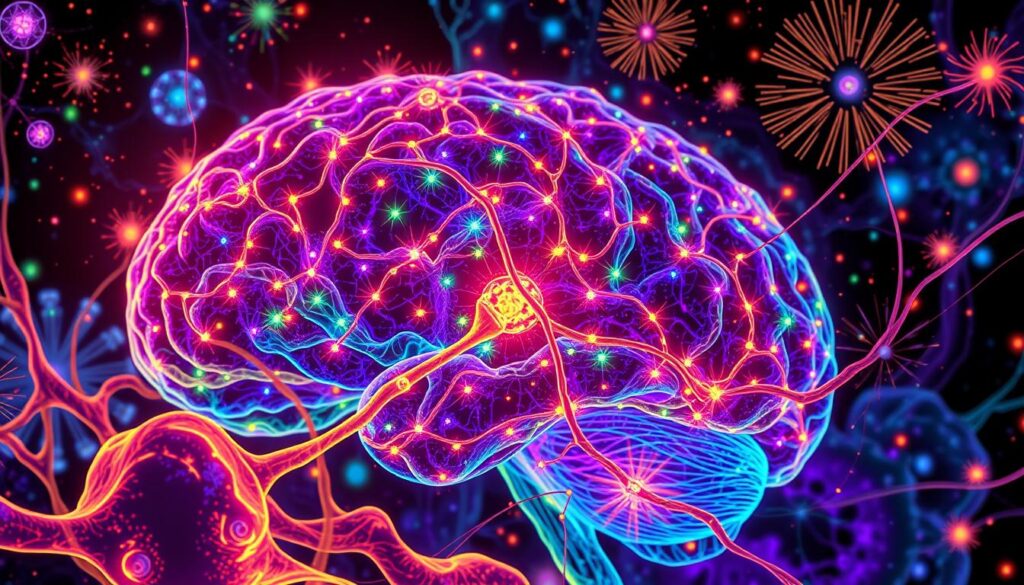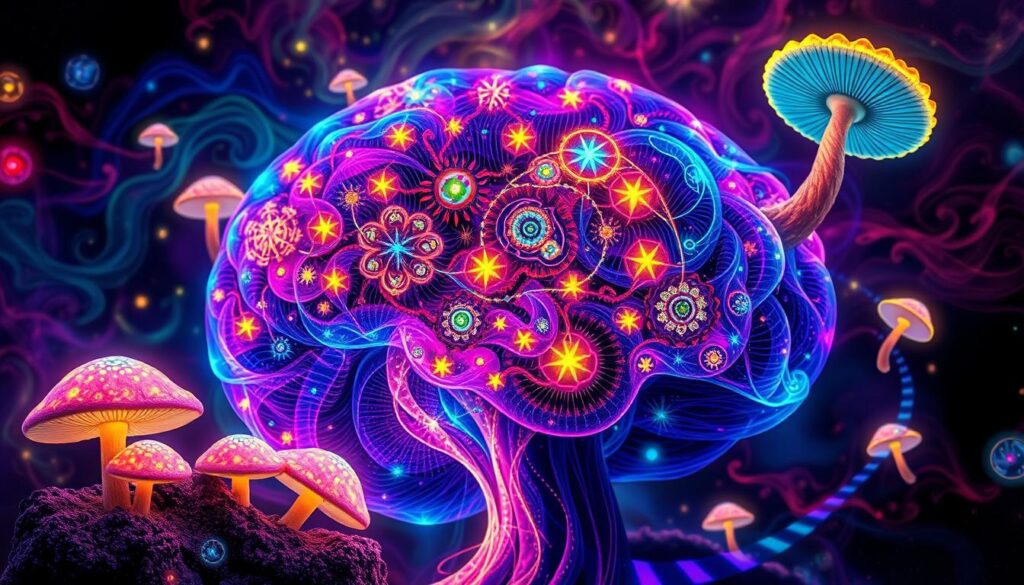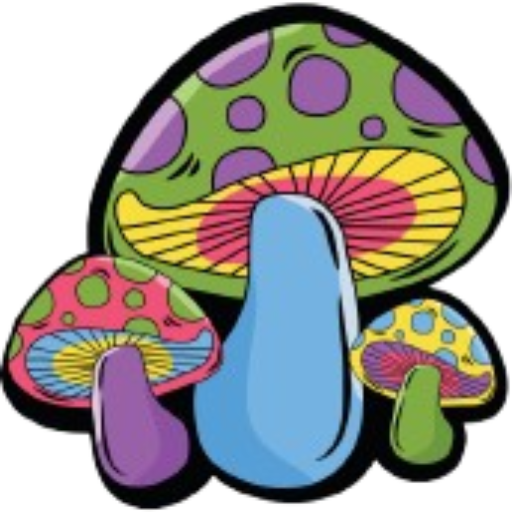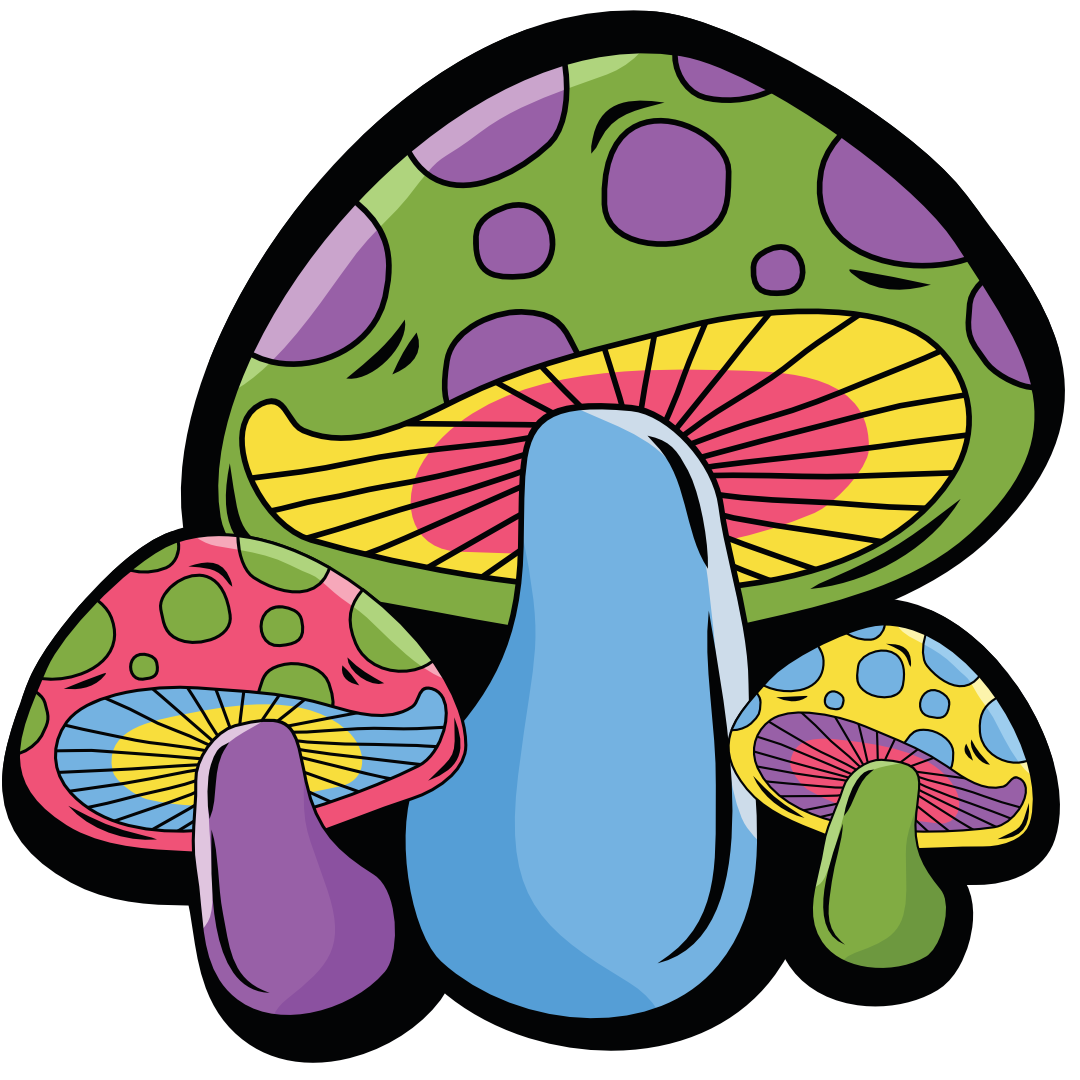Psilocybin, a naturally occurring psychedelic compound found in more than 200 species of fungi, is known for its mind-altering effects1. Once ingested, psilocybin is rapidly metabolized into psilocin, which then acts on serotonin receptors in the brain, leading to altered perception, changes in brain activity and connectivity, and potential therapeutic benefits2. The psychedelic experiences induced by psilocybin typically last 2-6 hours and can include euphoria, visual and mental hallucinations, and a distorted sense of time.
Psilocybin’s mechanism of action involves its interaction with serotonin-2A receptors in the brain, which are expressed on pyramidal cells and interneurons1. This interaction leads to excitatory postsynaptic potentials in the apical dendrites of neocortical pyramidal cells, modulating the activity of fast-spiking interneurons and synchronous activity in the prefrontal cortex1. Additionally, psilocybin has been shown to disrupt the brain’s default mode network, responsible for reflective thinking, leading to its mind-altering effects2.
The therapeutic potential of psilocybin is an area of growing interest, with research suggesting it may be effective in treating conditions such as depression, addiction, and end-of-life anxiety3. Psilocybin’s ability to induce changes in brain connectivity and function, which can persist for weeks after administration, may contribute to its potential therapeutic applications23.,
Introduction to Psilocybin
Psilocybin, also known as 4-phosphoryloxy-N,N-dimethyltryptamine (4-PO-DMT), is a naturally occurring psychedelic compound found in more than 200 species of fungi4. This compound has been used in spiritual and divinatory ceremonies by indigenous cultures in Mesoamerica for centuries. The first documented Western encounters with psilocybin mushrooms occurred in the 16th century when Spanish chroniclers described their use by native populations4.
What is Psilocybin?
In 1958, Swiss chemist Albert Hofmann isolated and identified the active compounds psilocybin and psilocin4. Psilocybin is a tryptamine derivative that acts as a serotonin 2A receptor agonist, leading to a range of psychoactive effects when ingested.
History and Cultural Use of Psilocybin Mushrooms
The use of psilocybin-containing mushrooms has a long history in Mesoamerican indigenous cultures, where they were revered for their spiritual and divinatory properties5. These psychedelic rituals and practices have been documented in various historical sources, reflecting the deep cultural significance of these substances within these communities.
“Psilocybin mushrooms have been used in spiritual and divinatory ceremonies by indigenous cultures in Mesoamerica for centuries.”
The shifting regulatory landscape for psilocybin is also noteworthy, with several states in the United States, such as Colorado and Oregon, having legalized therapeutic use of the compound4. As research into the potential therapeutic applications of psilocybin continues to expand, the regulatory approval for its use by the U.S. Food and Drug Administration (FDA) is being targeted by the end of 20254.
Physiological Effects of Psilocybin
Psilocybin, the primary psychoactive compound found in certain mushrooms, elicits a range of physiological and psychological effects. At the core of these mind-altering experiences is psilocybin’s interaction with serotonin receptors, particularly the 5-HT2A receptor, in the brain6. This activation leads to changes in brain activity and connectivity, ultimately contributing to the altered perception and consciousness that users report.
Altered Perception and Consciousness
The consumption of psilocybin can induce a profound and multifaceted shift in one’s subjective experience. Users often describe feelings of euphoria, enhanced sensory awareness, and a distorted perception of time and space6. These alterations in perception and consciousness are believed to stem from the disruption of the brain’s default mode network, which is associated with self-referential thought and rumination6.
Changes in Brain Activity and Connectivity
Psilocybin has been shown to increase overall communication between brain regions that typically do not interact as closely6. This enhanced connectivity, along with the modulation of specific neural pathways, contributes to the profound shifts in consciousness and perception experienced by users6. Researchers continue to explore the complex mechanisms underlying these physiological changes and their potential therapeutic applications.

“Psilocybin appears to temporarily disrupt the brain’s default mode network, which is associated with self-referential thoughts and rumination. This effect may contribute to the therapeutic benefits of psilocybin for conditions like depression and anxiety.”
The physiological effects of psilocybin, driven by its interaction with serotonin receptors and its impact on brain activity and connectivity, underlie the profound changes in perception and consciousness reported by users6. This complex interplay between neurochemical and neurophysiological processes continues to be a topic of intense scientific investigation and clinical exploration67.
Neurochemical Mechanisms of Psilocybin
Psilocybin, the primary psychoactive compound found in certain mushrooms, undergoes a rapid transformation into its active metabolite, psilocin8. Psilocin then binds to the serotonin 2A (5-HT2A) receptors in the brain, leading to a cascade of neurochemical effects8. This activation of the 5-HT2A receptors has been shown to modulate the release and activity of other neurotransmitters, such as glutamate and GABA, as well as influence brain wave patterns, including increased gamma and altered low-frequency oscillations8.
Interaction with Serotonin Receptors
Psilocybin’s psychoactive effects are largely attributed to its interaction with the serotonin 2A (5-HT2A) receptors in the brain89. Once metabolized into psilocin, the compound binds to these receptors, triggering a series of downstream effects that contribute to the altered perception, consciousness, and cognition experienced by users89.
Effects on Neurotransmitters and Brain Waves
The activation of 5-HT2A receptors by psilocin leads to changes in the levels and activity of other neurotransmitters, such as glutamate and GABA8. These neurotransmitter alterations, along with the modulation of brain wave patterns, including increased gamma and altered low-frequency oscillations, are believed to be crucial in the profound psychedelic effects of psilocybin8.
Understanding the neurochemical mechanisms underlying psilocybin’s effects is crucial for exploring its potential therapeutic applications, as well as for understanding the broader implications of serotonergic psychedelics and their impact on the human brain89.
“The neurochemical changes induced by psilocybin are believed to be a key factor in the compound’s profound effects on perception, consciousness, and cognition.”
how psilocybin works
The primary mechanism by which psilocybin exerts its psychoactive and therapeutic effects is through the activation of serotonin 2A receptors in the brain10. Once ingested, psilocybin is rapidly converted into psilocin, which then binds to these receptors, leading to a range of neurophysiological changes10.
These changes include increased connectivity between brain regions, enhanced neuroplasticity, and disruption of the default mode network10. This alteration of brain activity and dynamics contributes to the unique perceptual, emotional, and cognitive experiences observed with psilocybin use1011.
Psilocybin has been found to reduce neural activity in the claustrum region of the brain by 15% to 30%11, which is associated with stronger subjective effects such as emotional and mystical experiences11. This disruption of the claustrum’s communication with other brain regions involved in hearing, attention, decision-making, and memory further highlights the complex neurophysiological mechanisms underlying psilocybin’s effects11.
Ultimately, the unique way in which psilocybin interacts with the brain’s serotonin system and alters neural connectivity and dynamics is believed to underlie its potential therapeutic applications, particularly in the treatment of conditions like depression and anxiety10. Continued research in this area aims to further elucidate the precise mechanisms by which psilocybin exerts its remarkable effects on the human mind and brain10.

Therapeutic Potential
The therapeutic potential of psilocybin, the psychoactive compound found in certain mushrooms, has been a subject of growing interest and research in recent years12. Studies have demonstrated that psilocybin, when administered in a controlled, therapeutic setting, can lead to significant and long-lasting improvements in the treatment of various mental health conditions, including treatment-resistant depression, anxiety disorders, and substance abuse.
One notable study in 2016 showed that psilocybin produced substantial and sustained decreases in depression and anxiety in patients with life-threatening cancer12. Additionally, a pilot study in 2011 found that psilocybin treatment was effective in reducing anxiety in patients with advanced-stage cancer12. Furthermore, a 2016 open-label feasibility study demonstrated that psilocybin, combined with psychological support, could be a promising treatment for individuals with treatment-resistant depression12.
Treatment for Depression and Anxiety
The neuroplastic and consciousness-altering effects of psilocybin are believed to be the driving force behind its therapeutic benefits13. A study at Johns Hopkins Medicine in 2020 showed that two doses of psilocybin with psychotherapy led to rapid and significant reductions in depression symptoms in participants13. Moreover, a large trial with 233 participants across 10 countries demonstrated that a single dose of psilocybin significantly reduced symptoms of depression in treatment-resistant patients13. Psilocybin is expected to receive FDA approval for depression by the end of the decade13.
Potential Applications in Other Disorders
The therapeutic potential of psilocybin extends beyond depression and anxiety14. Preliminary reports have shown promising results in the treatment of obsessive-compulsive disorder, end-of-life psychological distress, alcohol and tobacco addiction, and even schizophrenia14. Additionally, a meta-analysis of studies conducted in the past found that 79% of patients showed ‘clinically judged improvement’ post-treatment with psychedelics for mood disorders14.
While the therapeutic potential of psilocybin is undeniable, researchers emphasize the importance of integrating therapy with psilocybin treatment for sustainable and effective results13. There are also ongoing concerns about the potential risks, such as the triggering of psychotic episodes, making it unsafe for individuals with certain psychiatric conditions13.
“Psilocybin-assisted psychotherapy shows promise in treating various mental health conditions, including depression, substance use disorders, anxiety, chronic pain, and more.”
Microdosing and Long-Term Effects
The practice of psilocybin microdosing, or taking sub-perceptual doses of psilocybin several times per week, has gained attention for its potential to enhance mood, creativity, and cognitive function15. However, the scientific evidence for the benefits of microdosing remains inconclusive, as some studies have failed to find significant effects beyond the placebo response15.
Interestingly, psilocybin long-term effects on the brain and overall health are still being investigated by researchers. Studies suggest that psilocybin may have a positive impact on psilocybin neuroplasticity and psilocybin brain health, potentially leading to psilocybin for cognitive enhancement16.
According to recent surveys17, the majority of respondents were either currently microdosing or had previously tried low-dose psilocybin. The most commonly used psychedelics for microdosing were lysergic acid diethylamide (10 mcg) and psilocybin (0.5 g), with a microdosing frequency ranging between 2 and 4 times per week17.
Interestingly, the study indicated that only one-fifth of the respondents experienced negative effects, primarily of a psychological nature, occurring acutely while under the influence17.
While the long-term effects of psilocybin use are still being explored, the potential benefits of psilocybin microdosing for mood, creativity, and cognitive function continue to generate interest and ongoing research.
Legal Status and Safety Considerations
Psilocybin, the primary psychoactive compound found in “magic mushrooms,” has a complex legal landscape across the globe18. It is currently classified as a Schedule I controlled substance under the 1971 United Nations Convention on Psychotropic Substances, indicating a perceived high potential for abuse and no accepted medical use18. However, the growing evidence of psilocybin’s therapeutic potential in treating mental health disorders has led to efforts in some countries and jurisdictions to reclassify or decriminalize it19.
Current Legal Landscape
While psilocybin remains illegal in many parts of the world, including the United Kingdom, some countries and regions have taken steps to loosen restrictions19. For instance, the Bahamas and the British Virgin Islands have legalized the possession and use of psilocybin, though not its sale19. In the United States, several states and cities have decriminalized or legalized the possession and use of psilocybin for personal or therapeutic purposes, including Oregon, Colorado, and Washington, D.C19.
Safety Profile and Potential Risks
Psilocybin is generally considered to have a relatively low risk of addiction and a relatively safe profile when used in a controlled, therapeutic setting18. However, potential risks include nausea, anxiety, and, in rare cases, psychotic episodes18. The concurrent use of psilocybin with other substances, such as cannabis and alcohol, can increase the risk of adverse events18. Additionally, there is a lack of studies evaluating the long-term effects of repetitive psilocybin use18.
Despite these considerations, clinical trials are ongoing to further explore the therapeutic potential of psilocybin in mental health disorders, such as treatment-resistant depression and anxiety18. In Canada, Health Canada provides pathways for legal access to psilocybin for therapeutic use, including through clinical trials, the Special Access Program, and individual exemptions from the Controlled Drugs and Substances Act18. These programs have safeguards in place to protect patients’ health and safety and ensure drug quality control18.
“The legal status of psilocybin is a complex and evolving landscape, reflecting the ongoing debate around its potential risks and benefits. As research continues to uncover the therapeutic applications of this compound, the regulatory landscape is likely to continue shifting in the coming years.”
Ongoing Research and Future Directions
The field of psilocybin research has experienced a resurgence in the past decade, with numerous20 clinical trials and studies exploring its therapeutic potential for a range of mental health conditions. The FDA has designated psilocybin as a “breakthrough therapy” for the treatment of depression21, highlighting the growing scientific and medical interest in this compound. As research continues, future directions may include further exploration of psilocybin’s mechanisms of action, optimization of dosing and administration protocols, and the development of psilocybin-based medications for various psychiatric and neurological disorders.
Recent20 studies have shown that psilocybin has strong antidepressant effects, and psilocybin-assisted psychotherapy (PAP) has demonstrated extremely large effect sizes in treating depressive disorders20. Clinical trials using psilocybin to treat mental health disorders have been registered, with 88 trials listed on clinicaltrials.gov at the time of writing20. Psilocybin is also being researched for its potential effectiveness in treating a variety of other conditions, such as anorexia nervosa, alcohol use disorder, and obsessive-compulsive disorder.
Advancing the scientific understanding of psilocybin’s mechanisms of action and its impact on the brain is a critical area of focus for researchers20. Neuroimaging studies have shown that psilocybin significantly alters the functional organization of the brain, providing valuable insights into its effects on cognition, emotion, and behavior22. The unique mechanism of action of psilocybin, allowing for infrequent dosing with durable effects and minimal toxicity, makes it a promising candidate for further drug development and therapeutic applications.

